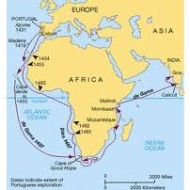
Īrab traders eventually took over conveying goods via the Levant and Venetian merchants to Europe until the rise of the Seljuk Turks in 1090. By mid-7th century AD, after the rise of Islam, Arab traders started plying these maritime routes and dominated the western Indian Ocean maritime routes. By this period, trade routes existed from Sri Lanka (the Roman Taprobane) and India, which had acquired maritime technology from early Austronesian contact. During the first millennium AD, Ethiopians became the maritime trading power of the Red Sea. Within specific regions, the Kingdom of Axum (5th century BC–AD 11th century) had pioneered the Red Sea route before the 1st century AD. The Austronesian maritime trade lanes later expanded into the Middle East and eastern Africa by the 1st millennium AD, resulting in the Austronesian colonization of Madagascar.

These goods were then transported by land towards the Mediterranean and the Greco-Roman world via the incense route and the Roman–India routes by Indian and Persian traders. The maritime aspect of the trade was dominated by the Austronesian peoples in Southeast Asia, namely the ancient Indonesian sailors who established routes from Southeast Asia to Sri Lanka and India (and later China) by 1500 BC. These spices found their way into the Near East before the beginning of the Christian era, with fantastic tales hiding their true sources. Spices such as cinnamon, cassia, cardamom, ginger, pepper, nutmeg, star anise, clove, and turmeric were known and used in antiquity and traded in the Eastern World. The spice trade involved historical civilizations in Asia, Northeast Africa and Europe. 1453, which spurred the Age of Discovery and European Colonialism. 1090, causing the Crusades, and by the Ottoman Empire c. Historic international commerce European access to the economically important Silk Road (red) and spice trade routes (blue) was blocked by the Seljuk Empire c.


 0 kommentar(er)
0 kommentar(er)
